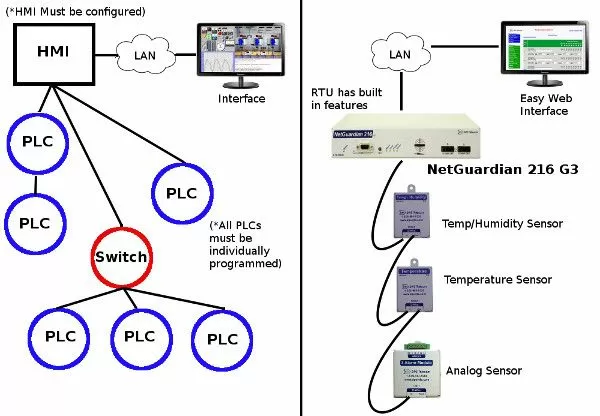Check out our White Paper Series!
A complete library of helpful advice and survival guides for every aspect of system monitoring and control.
1-800-693-0351
Have a specific question? Ask our team of expert engineers and get a specific answer!
Sign up for the next DPS Factory Training!

Whether you're new to our equipment or you've used it for years, DPS factory training is the best way to get more from your monitoring.
Reserve Your Seat TodayProgrammable Logic Controllers (PLCs) and Remote Telemetry/Terminal Units (RTUs) are two types of devices used for supervisory control and data acquisition (SCADA). They are often used to solve similar problems and talked about interchangeably.
But are they really the same? Is there an advantage to using one over the other? PLCs and RTUs both perform the same basic function: remote alarm monitoring and control of remote equipment. How they go about doing that job, however, varies significantly.
PLCs are simple devices; usually a single sensor and a communications interface to output sensor data. They can also be highly customizable. But make no mistake; they have a steep learning curve as they must be individually programmed in order to perform a task. Unless you have a resident PLC coder, you will have to pay an outside expert a lot of money.
Whether you program your PLCs in-house or hire an expert to do it for you, you're looking at a long wait before you're operational. It can take as long as several months just to get everything coded and connected.
Remote monitoring isn't your only job. You have to consider how much time you can devote to programming PLCs and if its worth the effort. Usually, it isn't. What you need is a solution with intelligence built-in that you can quickly get up and running.

In most cases, RTUs are a better approach. Here are a few reasons:
Although RTUs have many benefits over PLCs, RTUs' disadvantage is that if you need the freedom to totally program your device, they will not be the best solution. That is because they come pre-programmed from the manufacturer. You can find vertically integrated manufacturers that can build you a perfect-fit solution, but if you have a small local network and want to code your own device, then PLCs might be a better choice for you.

The NetGuardian 216 G3 by DPS Telecom is an advanced RTU that provides all the functionality you need to monitor your operations. The NetGuardian 216 G3 requires no coding and features a simple graphical web browser interface that allows you to set preferences and provision your unit easily. The NetGuardian 216 G3 is also scalable - with the ability to report to up to 2 master stations.
Plus, DPS Tech support is available 24/7 to answer any questions you or your techs may have. Get help directly from the engineers that build the RTUs. They never read from a script and are happy to help you until your RTU is fully operational.
Need more than just some over-the-phone tech support? DPS also offers a factory training course multiple times a year at their headquarters or at a regional location. Get hands-on training from the engineers that build your RTUs.
At DPS, we receive many urgent quote requests after an earlier "Do Nothing" decision comes back to bite you. You have no reason not to be proactive (and maybe you'll manage to impress your boss).
Call us. Chat with an expert for 10 minutes. We'll email you a detailed quote with a custom application drawing. We'll even include a summary of business benefits you can use to justify your project budget.
Call 1-800-693-0351 now for your quote or send us a quick online message instead